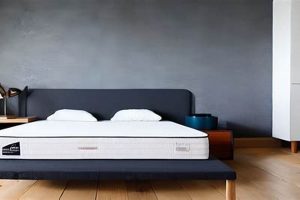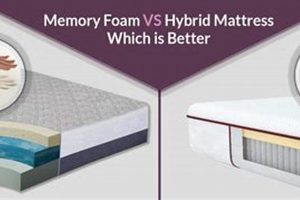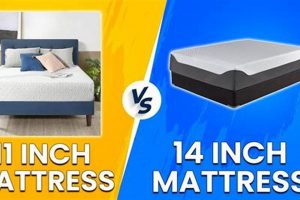The central consideration involves two distinct mattress construction methods. One relies on a system of metal coils for support, while the other utilizes various densities and compositions of manufactured materials. Understanding the fundamental differences in their core architecture is essential for informed decision-making.
This distinction is significant because it directly impacts factors such as support, motion isolation, temperature regulation, and durability. The choice between these constructions influences sleep quality and overall comfort. Historically, coil-based systems were the dominant technology, but advancements in material science have led to increased popularity and innovation in alternative constructions.
The subsequent discussion will delve into the specific characteristics of each type. A detailed examination of their respective strengths and weaknesses will provide a clearer understanding of how each option addresses individual sleep preferences and requirements. We will explore their performance concerning support, pressure relief, motion transfer, and temperature neutrality.
Considerations for Mattress Selection
Selecting the appropriate mattress requires careful evaluation of individual needs and preferences. The following points offer guidance in navigating the decision-making process.
Tip 1: Assess Sleep Style: Individuals who primarily sleep on their side may benefit from enhanced pressure relief, potentially favoring one construction method over another. Back sleepers often require firmer support, a characteristic often associated with specific coil configurations.
Tip 2: Evaluate Support Requirements: Body weight influences the level of support needed to maintain spinal alignment. Heavier individuals may require a more robust core support system, potentially limiting the suitable options.
Tip 3: Analyze Temperature Sensitivity: Certain materials exhibit greater heat retention than others. Individuals prone to overheating during sleep should prioritize options with enhanced breathability and cooling properties.
Tip 4: Examine Motion Isolation Needs: Couples sharing a bed should consider the motion isolation capabilities. Superior motion isolation minimizes disturbances caused by movement during the night.
Tip 5: Review Edge Support: Strong edge support provides a stable surface for sitting and prevents the sensation of rolling off the mattress. This feature is particularly important for individuals who utilize the entire surface area.
Tip 6: Inquire About Trial Periods and Warranties: Reputable manufacturers offer trial periods allowing consumers to test the mattress at home. Comprehensive warranties provide protection against manufacturing defects and premature wear.
Tip 7: Research Material Composition: Understanding the materials used in construction enables informed comparisons regarding durability, comfort, and potential allergens. Certifications from independent organizations can provide assurance regarding material safety.
Careful consideration of these factors will facilitate a more informed decision, leading to improved sleep quality and long-term satisfaction. Ultimately, the ideal choice depends on aligning mattress characteristics with individual needs and preferences.
The subsequent sections will explore the specific features and benefits of each construction type, providing further clarity in the selection process.
1. Support and Firmness
Support and firmness, critical components of any sleep surface, manifest distinctly in innerspring and foam mattresses. Innerspring systems derive their support primarily from the coil structure. The gauge and configuration of the coils dictate the overall firmness and the ability to resist compression under weight. A higher coil count or thicker gauge typically translates to a firmer feel and increased support, particularly beneficial for individuals requiring enhanced spinal alignment. For example, an innerspring mattress with a tightly packed arrangement of high-gauge coils would provide a more stable and rigid surface compared to one with fewer, thinner coils, making it suitable for heavier individuals or those with back pain.
In contrast, foam mattresses achieve support and firmness through the density and composition of the foam layers. High-density foams offer greater resistance to compression, resulting in a firmer feel and improved support. Layering different foam types allows manufacturers to create mattresses with varying degrees of firmness and contouring. A foam mattress combining a high-density support core with a softer comfort layer would offer a balance of support and pressure relief. For instance, memory foam, known for its conforming properties, often comprises the top layer, while a denser polyurethane foam provides the underlying support.
The practical significance of understanding the relationship between construction and support/firmness lies in matching the mattress to individual needs. Incorrect selection can lead to discomfort, poor sleep quality, and potential health issues. Choosing between innerspring and foam hinges on preferred feel, body weight, and any specific support requirements. Although both types can provide adequate support, the method through which they achieve it coils versus foam density results in a fundamentally different sleeping experience.
2. Motion Isolation Capacity
Motion isolation capacity, a crucial consideration for shared sleeping spaces, differs significantly between innerspring and foam mattress constructions. This characteristic dictates the degree to which movement on one side of the mattress is transferred to the other, directly impacting sleep quality for co-sleepers.
- Interconnected Coil Systems and Motion Transfer
Traditional innerspring mattresses often feature interconnected coil systems. When pressure is applied to one area, the surrounding coils also react, resulting in motion transfer across the surface. This interconnectedness reduces motion isolation, as movement on one side generates noticeable disturbances on the other. The extent of transfer depends on the coil gauge, the number of coils, and the overall design. For instance, a continuous coil system is likely to exhibit more motion transfer than a pocketed coil system.
- Pocketed Coils: An Advancement in Motion Isolation
Pocketed coil systems represent an advancement aimed at mitigating motion transfer in innerspring mattresses. Each coil is individually encased in fabric, allowing it to compress independently. This reduces the ripple effect associated with interconnected coils, limiting the transmission of movement. However, even with pocketed coils, some degree of motion transfer may still occur, particularly with vigorous movement or significant weight disparities between sleepers.
- Foam Composition and Dampening of Movement
Foam mattresses, particularly those constructed with memory foam or latex, excel in motion isolation due to their inherent damping properties. These materials absorb and dissipate energy, minimizing the transmission of movement across the mattress surface. High-density foams, in particular, exhibit superior motion isolation capabilities, effectively preventing disturbances from reaching a sleeping partner. For example, a memory foam mattress can significantly reduce the sensation of a partner getting in or out of bed during the night.
- Hybrid Designs: Balancing Support and Isolation
Hybrid mattresses, combining elements of both innerspring and foam construction, attempt to strike a balance between support and motion isolation. These mattresses typically feature a pocketed coil base for support and a top layer of foam (e.g., memory foam or latex) for comfort and motion dampening. The effectiveness of motion isolation in a hybrid design depends on the thickness and density of the foam layer, as well as the specific configuration of the coil system.
Ultimately, when prioritizing motion isolation, foam mattresses generally outperform traditional innerspring models. While pocketed coil innerspring and hybrid designs offer improvements, the inherent properties of foam contribute to superior dampening of movement. Selecting the appropriate construction requires careful consideration of individual sleep needs and partner preferences.
3. Temperature neutrality levels
Temperature neutrality, defined as the ability of a sleep surface to regulate temperature and minimize heat retention, is a critical factor in mattress selection. The construction of innerspring and foam mattresses significantly impacts this characteristic. Innerspring systems, by virtue of their open structure, generally exhibit superior airflow compared to their foam counterparts. The space between the coils allows for greater ventilation, facilitating the dissipation of heat and moisture. This inherent breathability contributes to a cooler sleeping experience, particularly beneficial for individuals prone to overheating or residing in warmer climates. For instance, an innerspring mattress with a minimal comfort layer will likely maintain a lower temperature throughout the night compared to a densely packed foam mattress.
Foam mattresses, on the other hand, tend to retain more heat due to their denser structure and reduced airflow. Traditional memory foam, in particular, is known for its heat-retentive properties. The closed-cell structure restricts ventilation, trapping body heat and potentially leading to discomfort. However, advancements in foam technology have led to the development of open-cell memory foam and gel-infused foams, designed to enhance breathability and mitigate heat retention. Open-cell foam features larger air pockets, promoting airflow, while gel infusions are intended to draw heat away from the body. Despite these innovations, foam mattresses typically require additional cooling technologies, such as breathable covers or cooling pads, to achieve comparable temperature neutrality to innerspring models. For example, a high-density memory foam mattress, even with gel infusions, may still require a breathable mattress protector to maintain a comfortable temperature for some individuals.
The practical significance of understanding temperature neutrality levels lies in aligning mattress selection with individual thermal comfort preferences. Innerspring mattresses offer a natural advantage in breathability, making them a suitable option for hot sleepers. Foam mattresses, while potentially warmer, can be modified with cooling technologies to improve temperature regulation. Ultimately, the ideal choice depends on a careful assessment of individual needs, environmental conditions, and any specific thermal sensitivities. Challenges remain in achieving true temperature neutrality across all mattress types, highlighting the ongoing research and development efforts in material science and mattress design.
4. Durability expectations
Durability expectations represent a critical purchase consideration in the “innerspring vs foam mattress” comparison. Mattress longevity directly impacts the overall cost-effectiveness and long-term satisfaction of the product. The expected lifespan is intrinsically linked to the materials and construction methods employed in each mattress type. Innerspring mattresses, historically, have been associated with a specific set of durability challenges related to coil fatigue, upholstery compression, and potential frame degradation. Foam mattresses present a different set of durability considerations, primarily centered on foam density, resilience, and resistance to long-term compression and degradation. Understanding these differing failure modes is essential for informed decision-making.
In the context of innerspring mattresses, coil fatigue, the gradual loss of springiness in the coils, can lead to sagging and reduced support over time. Higher-gauge steel coils generally exhibit greater resistance to fatigue compared to lower-gauge coils. Upholstery compression, the flattening of the comfort layers above the coil system, can also impact durability and comfort. High-quality upholstery materials, such as natural latex or high-density foams, are more resistant to compression and provide longer-lasting support. Furthermore, the frame and foundation of an innerspring mattress play a crucial role in its overall durability. A weak or inadequate frame can contribute to premature sagging and structural failure.
Foam mattresses, conversely, face durability challenges related to foam density and resilience. Lower-density foams are more susceptible to compression and degradation, resulting in a loss of support and comfort over time. High-density foams, such as memory foam or high-density polyurethane foam, offer greater resistance to compression and provide a more durable sleeping surface. The resilience of the foam, its ability to recover its original shape after compression, is also a critical factor. Foams with high resilience tend to maintain their support and comfort characteristics for a longer period. Ultimately, the expected lifespan of a foam mattress depends heavily on the quality and density of the foam layers used in its construction. The trade-offs between initial cost and long term performance are therefore essential decision making parameters.
5. Pressure Relief Capabilities
Pressure relief capabilities represent a pivotal aspect in evaluating mattress performance, directly influencing comfort and minimizing potential discomfort, particularly at pressure points such as the shoulders, hips, and knees. The manner in which innerspring and foam mattresses address pressure relief differs fundamentally due to their distinct construction and material properties.
- Conforming Properties of Foam
Foam mattresses, especially those incorporating memory foam or latex, excel in pressure relief due to their ability to conform closely to the body’s contours. This conforming action distributes weight more evenly, reducing concentrated pressure on specific areas. Memory foam, for example, softens in response to body heat and weight, molding precisely to the sleeper’s shape and alleviating pressure points. Latex, while offering less dramatic contouring than memory foam, provides a responsive and resilient surface that also effectively distributes weight.
- Surface Tension in Innerspring Systems
Traditional innerspring mattresses, with their interconnected coil systems, often exhibit greater surface tension compared to foam mattresses. This can result in increased pressure on prominent body parts, particularly for side sleepers or individuals with sensitive pressure points. The coils, while providing support, may not conform sufficiently to the body’s curves, leading to localized pressure and potential discomfort. The addition of a substantial comfort layer atop the coils can mitigate this effect to varying degrees.
- Zoned Support in Mattress Design
Both innerspring and foam mattresses may incorporate zoned support systems to enhance pressure relief. Zoned designs utilize varying firmness levels in different areas of the mattress to provide targeted support and pressure relief to specific body regions. For example, a mattress might feature softer foam or coils in the shoulder and hip areas to allow for greater compression and pressure relief, while firmer support is provided in the lumbar region to maintain spinal alignment. These zoned systems aim to optimize comfort and minimize pressure points for a wider range of sleep positions and body types.
- Impact of Toppers and Comfort Layers
The addition of toppers or thick comfort layers can significantly alter the pressure relief characteristics of both innerspring and foam mattresses. A memory foam topper, for instance, can enhance the pressure-relieving properties of an innerspring mattress, while a latex topper can add responsiveness and resilience to a foam mattress. The thickness and density of the comfort layers play a crucial role in determining the overall level of pressure relief provided by the mattress. Experimentation with different toppers can be a cost-effective way to customize the feel and pressure relief capabilities of an existing mattress.
The differing approaches to pressure relief in innerspring and foam mattresses underscore the importance of considering individual sleep preferences and needs. While foam mattresses generally offer superior conforming and pressure-relieving properties, innerspring mattresses with appropriate comfort layers and zoned support systems can also provide adequate pressure relief for many sleepers. The optimal choice depends on factors such as body weight, sleep position, and sensitivity to pressure points.
6. Cost Analysis Comparison
The comparative analysis of expenses associated with innerspring versus foam mattresses constitutes a crucial element in the purchasing process. Cost considerations extend beyond the initial purchase price, encompassing factors such as longevity, maintenance, and potential replacement frequency. A comprehensive cost analysis provides a more accurate understanding of the long-term financial implications of each mattress type.
- Initial Purchase Price Disparities
The initial investment typically varies significantly. Innerspring mattresses generally present a lower entry-level cost, primarily due to established manufacturing processes and readily available materials. Foam mattresses, particularly those utilizing advanced materials like memory foam or latex, often command a higher initial price point, reflecting the cost of specialized materials and production techniques. However, promotional periods and brand positioning can influence these price dynamics.
- Long-Term Durability and Replacement Costs
The expected lifespan of each mattress type directly impacts long-term expenses. While innerspring mattresses may offer a lower initial cost, potential issues like coil fatigue or upholstery compression can necessitate earlier replacement, increasing overall costs. High-density foam mattresses, conversely, may exhibit greater durability and resilience, potentially extending their lifespan and reducing replacement frequency. Assessing historical performance data and warranty provisions is essential for estimating long-term durability.
- Maintenance and Upkeep Expenses
Maintenance requirements and associated costs should also be considered. Innerspring mattresses typically require regular flipping or rotating to promote even wear and prevent sagging. Foam mattresses, particularly those with a single-sided design, often require less maintenance. However, specialized cleaning products or protective covers may be necessary for both types to maintain hygiene and prolong their lifespan. The costs associated with these maintenance practices should be factored into the overall expense analysis.
- Total Cost of Ownership Considerations
The “total cost of ownership” encompasses the initial purchase price, estimated lifespan, potential maintenance expenses, and anticipated replacement costs. A comprehensive analysis of these factors provides a more accurate comparison of the long-term financial implications of innerspring versus foam mattresses. While an innerspring mattress may initially appear more affordable, a high-quality foam mattress with superior durability could prove more cost-effective over its lifespan. Consumers should weigh these factors against their budgetary constraints and long-term sleep needs.
Ultimately, the selection between innerspring and foam mattresses should incorporate a detailed cost analysis alongside considerations of comfort, support, and personal preferences. A thorough understanding of the long-term financial implications allows for a more informed and fiscally responsible purchasing decision, optimizing both sleep quality and budget management.
7. Weight considerations
Body weight significantly influences mattress performance and longevity, making it a crucial factor in the innerspring versus foam mattress selection. The ability of a mattress to provide adequate support, maintain its structural integrity, and resist sagging depends heavily on its capacity to accommodate the user’s weight. Disregarding this parameter can result in discomfort, reduced sleep quality, and premature mattress failure.
- Coil Gauge and Support for Heavier Individuals
In innerspring mattresses, coil gauge, the thickness of the steel wire used to construct the coils, directly correlates to the mattress’s weight-bearing capacity. Higher-gauge coils (e.g., 12-gauge) are thicker and more robust, providing greater support and resistance to compression under heavier loads. Individuals with higher body weights require mattresses with higher-gauge coils to prevent sagging and maintain proper spinal alignment. Failure to select an innerspring mattress with sufficient coil support can lead to discomfort, back pain, and a significantly shortened lifespan of the mattress. An individual exceeding 250 pounds, for instance, would likely require a mattress with a coil gauge of 13 or lower to ensure adequate support and durability.
- Foam Density and Resistance to Compression
In foam mattresses, density, measured in pounds per cubic foot (PCF), serves as a primary indicator of support and durability. Higher-density foams offer greater resistance to compression, providing better support and preventing the formation of body impressions over time. Individuals with higher body weights should prioritize foam mattresses with high-density support cores (e.g., 2.5 PCF or higher) to ensure adequate support and prevent premature sagging. Conversely, lower-density foams may compress excessively under heavier loads, leading to discomfort and a reduced lifespan. A foam mattress with a support core density below 1.8 PCF, for example, might not provide sufficient support for individuals weighing over 200 pounds.
- Weight Distribution and Zoned Support Systems
Regardless of the mattress type, effective weight distribution is crucial for comfort and support. Zoned support systems, which incorporate varying firmness levels in different areas of the mattress, can help distribute weight more evenly and provide targeted support to specific body regions. For example, a mattress with firmer support in the lumbar region can help prevent sagging and maintain spinal alignment for individuals with higher body weights. Conversely, softer support in the shoulder and hip areas can provide pressure relief and improve comfort for side sleepers. These zoned systems can enhance the overall performance and longevity of the mattress, particularly for individuals with uneven weight distribution.
- Foundation Strength and Overall Support
The foundation or base upon which the mattress rests plays a critical role in providing overall support and preventing sagging, particularly for heavier individuals. A weak or inadequate foundation can exacerbate the effects of weight on the mattress, leading to premature wear and tear. Individuals with higher body weights should ensure that their mattress is supported by a sturdy and appropriate foundation, such as a solid platform bed or a reinforced box spring. A slatted bed frame with widely spaced slats, for instance, may not provide sufficient support for a heavy mattress, leading to sagging and reduced lifespan.
In conclusion, weight considerations are paramount when choosing between innerspring and foam mattresses. Selecting a mattress with adequate coil gauge or foam density, a supportive foundation, and potentially a zoned support system can significantly enhance comfort, support, and longevity, particularly for individuals with higher body weights. Neglecting these considerations can lead to discomfort, reduced sleep quality, and premature mattress failure, ultimately impacting the cost-effectiveness and overall satisfaction of the purchase.
Frequently Asked Questions
The following addresses common inquiries regarding the selection between these two mattress types, providing concise answers to facilitate informed decision-making.
Question 1: What are the primary distinctions influencing the overall sleeping experience?
Core construction methods differ significantly, influencing support, motion isolation, temperature regulation, and durability. Innerspring relies on coils; foam utilizes various densities of manufactured material.
Question 2: Which mattress type is generally recommended for individuals with back pain?
The suitability varies based on the specific cause and severity of back pain. Firmer innerspring models or high-density foam options offering targeted lumbar support may prove beneficial.
Question 3: How does each mattress type perform concerning motion isolation, particularly for co-sleepers?
Foam mattresses, especially those incorporating memory foam, typically exhibit superior motion isolation compared to traditional innerspring systems.
Question 4: What are the typical longevity expectations for innerspring versus foam mattresses?
Longevity depends on material quality and usage patterns. High-density foam mattresses often demonstrate greater durability than lower-quality innerspring models.
Question 5: Which option is considered more advantageous for individuals prone to overheating during sleep?
Innerspring mattresses, due to their open coil structure, generally offer better airflow and temperature regulation compared to denser foam options.
Question 6: What are the key cost considerations when choosing between these two types?
Cost analysis should encompass the initial purchase price, anticipated lifespan, and potential maintenance expenses to determine the overall value proposition.
Understanding these distinctions is crucial for aligning mattress selection with individual sleep preferences and budgetary constraints.
The subsequent section will provide a comprehensive summary, consolidating key insights to aid the decision-making process.
Innerspring vs Foam Mattress
The preceding analysis has illuminated the distinct characteristics of innerspring vs foam mattress designs. The investigation encompassed core construction, support mechanisms, motion isolation capabilities, temperature regulation properties, durability expectations, pressure relief effectiveness, and cost implications. These factors collectively influence the suitability of each mattress type for individual needs and preferences. The inherent qualities of coil-based systems and foam-based systems dictate their respective strengths and weaknesses, necessitating careful consideration during the selection process.
Ultimately, the optimal choice between an innerspring vs foam mattress necessitates a comprehensive self-assessment. Consumers must objectively evaluate their sleep style, support requirements, thermal sensitivities, and budgetary constraints. Informed decision-making, grounded in a thorough understanding of the information presented, will contribute to enhanced sleep quality and long-term satisfaction. Continued advancements in material science and mattress design promise further refinements in both categories, offering increasingly tailored solutions for diverse sleep needs.


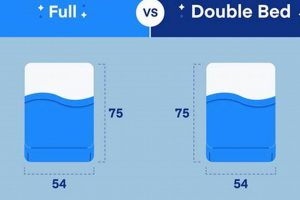
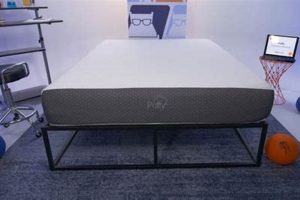
![Choosing Innerspring vs Memory Foam Mattress? [Guide] Organic & Natural Mattress Buyer’s Guide: Non-Toxic Sleep Solutions Choosing Innerspring vs Memory Foam Mattress? [Guide] | Organic & Natural Mattress Buyer’s Guide: Non-Toxic Sleep Solutions](https://mattressworldpa.com/wp-content/uploads/2025/07/th-1100-300x200.jpg)
